
The little blocks serve as a lifebar for the corresponding player. Despite the numbers, Billy actually has six lives and Jimmy has two although that’s about to change ...
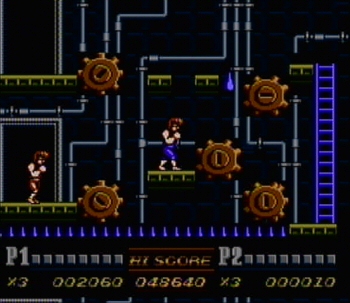
The game keeps score for each player, but the score serves no function. No extra lives, no powerups, nothing.
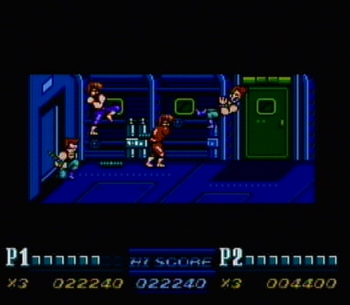
In addition to the arsenal of attacks Billy and Jimmy get, they can also pick up weapons dropped by enemies including grenades, dynamite sticks, knives, pipes, and whips.
Review by Jay Wilson There’s a mad brilliance to the design of Double Dragon II with its instant death environmental hazards and strict timing of the advanced maneuvers that keeps the game fun today after countless playthroughs. I can easily beat anything and everything the game throws at me and reliably beat Supreme Master solo without using the hidden code to continue. I can—and have—at various times beaten each and every level without losing a life ... but I’ve never done it all in one go. Somewhere along the way, at some point, there will come a moment when I carelessly jump too soon, where I overconfidently take the battle to the open helicopter door, where I slip up and fail to perform the hyper knee at the critical moment. And boom, I die a stupid death. I still have three lives, I can still finish the game, but damn it I know better! I should not have died there! Yes, the game appeals to my screwed up brand of reckless perfectionist gaming. One of these days, though—one of these days—I’ll have the perfect playthrough. I’ll navigate the danger zones with caution and punch/kick/uppercut those shadow warrior bastards to kingdom come! And I’ll get through the whole game on one life or die trying! It’s a sickness. I know. Released in 1990 for the Nintendo Entertainment System, Double Dragon II showcases an incredible diversity of available moves on the system’s two-button controller. One button always attacks left, the other always attacks right. Which direction Billy/Jimmy Lee is facing determines whether said attack is a forward punch or back kick. This allows the Lee brothers to drop the thug in front of them and then immediately hit the enemy coming up from behind without wasting time turning around. Pressing both buttons simultaneously allows you to jump, and while airborne pressing either attack button results in a standard jump kick; however, if you time it right and press attack at the jump’s peak you’ll perform the spin kick which hovers in mid air and hits all nearby enemies, sending them flying back. Then as you land, Billy and Jimmy will go into a crouch, making available the most damaging moves in the game. Pressing the punch button during the momentary crouch will result in the hyper uppercut, second in power only to the hyper knee unleashed by pressing both buttons during that same crouch. Reliable execution of these latter moves requires practice and dedication, but man, it’s so satisfying jumping in with a spin kick, seeing your opponent duck, landing, and hyper uppercutting the living crap out of that enemy (complete with an explosion sound effect). Or better yet, getting knocked down by a boss and performing a hyper knee as you stand back up. Yes, recovering from a knockdown leads to that same crouch animation allowing immediate retaliation if you can maintain your cool under pressure; in a way, it’s like enemies knock you down with a pitiful .22 and in the process they unknowingly hand you a bazooka. Right there you have five moves tied to two button (punch, kick, jump kick, hyper uppercut, hyper knee.) But wait, there’s more! Stand over a knocked down enemy and attack as they rise, you’ll perform a knee which stuns them allowing you to grab their hair and either knee them multiple times, throw them over your shoulder, or send them sky high with a kick. Or if you don’t want to grab them, simply pressing punch will perform an uppercut. 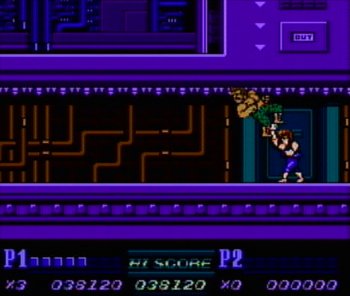
Many bosses appear much larger than standard enemies like this fellow who resembles Arnold Schwarzenegger in a pixelated NES kind of way.
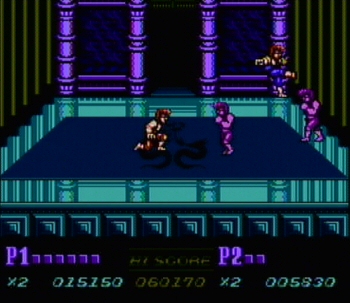
The arcade actually ends with the shadow illusions, but the NES game goes on to one more fight.
In other words, Double Dragon II offers something for every play style and every skill level. Me personally, I prefer to stay airborne with spin kicks and hyper knees whenever I can. In fact, instead of walking I like to travel across the screen performing perpetual hyper knees as practice. For those who can’t execute the advanced moves reliably or want to land attacks more consistently, there’s nothing wrong with old fashioned standing punch and kick (airborne moves do more damage, but enemies can duck them.) Amidst a battle, when the lifebars get low and death creeps near, the cool and calm player can patiently wait for the right frame to get off a hyper knee, and the frantic panicking button masher can rapidly push punch as fast as he can hoping to unleash a hyper uppercut (it only takes one to turn the tables.) There’s a bit of everything for everyone. On top of the vast attacking options, Double Dragon II brings some of the most unique environmental hazards. Unlike, say, Super Mario Brothers or Megaman (both great games) where enemies are designed to go with dangerous terrain, the spikes and pits in Double Dragon II are just as fatal to the bad guys as they are to our protagonists. Meaning you can spin kick enemies off rooftops in Mission Two, uppercut them off cliffs in Mission Five, or make them choose between getting sucked out an open helicopter door and eating your jump kick (and then get sucked out an open helicopter door) in Mission Three. The patient cautious player can wage their battles as far away from these hazards as the screen allows in relative safety, and the daring aggressive player can take the war right to the brink. Plus some of the hazards force a diversity in game play such as the spiked ceiling in Mission Four discouraging jumps (although, the damage dealt by a well timed hyper knee is well worth the damage taken). The crumbling bridges in Mission Seven bring an urgency to end the battle or, at the very least, get on the other side of the enemies so they fall off first. The steam engine in Mission Five, the vanishing platforms in Mission Six, and the shooting helicopter in Mission Two further diversifies the game with strategic dashes from the platformer genre. If that’s not enough and you have a second player, you can switch over to Two Player B which allows Billy and Jimmy Lee’s attacks to hurt each other meaning both players must coordinate their placement to maximize their effectiveness and minimize collateral damage. An interesting property of Two Player B, though, is that if one of the brothers deals the final blow to the other, he steals the life and vice versa. So, if there comes a pause in the action and Jimmy is down to one block of health, Billy can kill him, steal the life, and then Jimmy can turn around, steal it back, and both brothers can continue with full health and full lives. Alternatively, one person can start a two player B game, kill off the other brother completely, and have eight lives for the rest of the game. 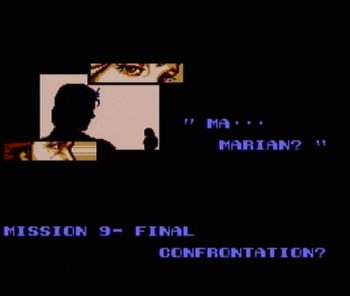
Before and after each mission, Double Dragon II continues the story with short, skippable, comic-book style narration. Very cool.
It’s not really necessary because if Double Dragon II has any faults, it’s too easy. Billy and Jimmy were given so many tools to work with that they can get out of just about any kind of trouble. But, given the choice between a game made easy by too many options and a game made difficult by denying players the proper means of dealing with the game’s challenges ... I’ll take the former in a heartbeat. | ||||||||||||||||||||
|
Note: I generally make it a practice not to review ports; however, the NES version of Double Dragon II: The Revenge is essentially an entirely new game from the original 1988 arcade release. | ||||||||||||||||||||
